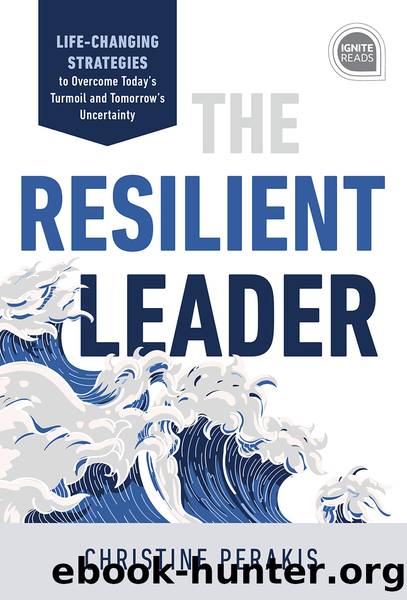The Resilient Leader by Christine Perakis

Author:Christine Perakis
Language: eng
Format: epub
Publisher: Sourcebooks
Published: 2020-02-24T00:00:00+00:00
8
Develop a Category 5 Leadership Style
“Anyone can hold the helm when the sea is calm.”
—Publilius Syrus
When disaster strikes, you need to find a role that serves yourself, your team, your family members, and your community.
Barometer #4: In a Category 5 situation, your ability to be successful and contribute in the aftermath of the event will depend on having and using the vision to assume a leadership role. Imagine setting out to prepare a dish that you have never prepared before, maybe something you’ve seen in a magazine or on a cooking show. What is the first thing that you do? You visualize the finished dish. There is nothing more important in culinary artistry (or artistry in any form) than to have a really clear vision in your mind of your outcome. Then you can work backward, get your timing right, and prepare your ingredients properly to get to that goal. In setting out on any journey, it can be as simple as plotting a course to a destination from where you are; taking a bearing; calculating how many days it will take to get there; being able to monitor supplies, progress, and conditions; and comparing your dead reckoning (the theoretical course plot) to what is actually happening in ever-changing conditions.
If you can see the possibilities in your situation, you can step up to move the community forward as a leader and assume one of four leadership roles that you can shoulder in the Category 5 landscape. The National Outdoor Leadership School (NOLS) outlines the four styles for expedition leadership as follows: designated leader, peer leader, self-leader, active followership.
The designated leader is an appointed role that is evident to everyone and carries certain authority. Irma was unsparing in her destruction—occupation, wealth, success, education, title—none of these could stave off the onslaught. Consequently, we could not count on our government officials, the designated leaders in our community. So, the community had to be served by other kinds of leaders.
Peer leadership involves playing your part on the team to work together toward common goals. This form of leadership is not designated. It is important that each member of the team recognizes what needs to be done and takes the initiative to go do it. Peer leadership is empowering to the team. Post-Irma, offshore and local organizations and individuals banded together to assist the recovery—including facilitating evacuations and the inflow of food, water, medical supplies, and personnel. Hurricane Maria forced the withdrawal of support from our Puerto Rican neighbors. With local supplies mostly diminished or inaccessible and other resources from abroad unreachable to our remote island, the situation was dire. Much could be accomplished with peer leadership engaged in the recovery.
Self-leadership involves building a culture where everyone takes care of themselves to the best of their ability, showing personal initiative and character. This is the single most important leadership role. Self-leadership will inspire peer leadership, and through that can come a much more evolved and mature active followership.
Active followership is recognizing the importance of
Download
This site does not store any files on its server. We only index and link to content provided by other sites. Please contact the content providers to delete copyright contents if any and email us, we'll remove relevant links or contents immediately.
Hit Refresh by Satya Nadella(8823)
The Compound Effect by Darren Hardy(8443)
Change Your Questions, Change Your Life by Marilee Adams(7324)
Nudge - Improving Decisions about Health, Wealth, and Happiness by Thaler Sunstein(7199)
The Black Swan by Nassim Nicholas Taleb(6725)
Deep Work by Cal Newport(6492)
Daring Greatly by Brene Brown(6194)
Rich Dad Poor Dad by Robert T. Kiyosaki(6114)
Principles: Life and Work by Ray Dalio(5876)
Man-made Catastrophes and Risk Information Concealment by Dmitry Chernov & Didier Sornette(5597)
Digital Minimalism by Cal Newport;(5328)
Playing to Win_ How Strategy Really Works by A.G. Lafley & Roger L. Martin(5326)
Big Magic: Creative Living Beyond Fear by Elizabeth Gilbert(5306)
The Myth of the Strong Leader by Archie Brown(5206)
The Slight Edge by Jeff Olson(5176)
Discipline Equals Freedom by Jocko Willink(5136)
The Motivation Myth by Jeff Haden(4967)
Stone's Rules by Roger Stone(4822)
The Laws of Human Nature by Robert Greene(4728)
